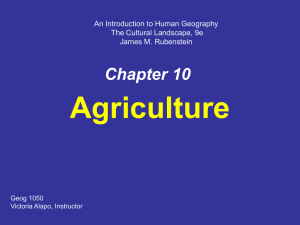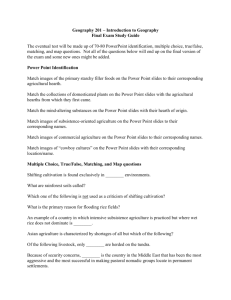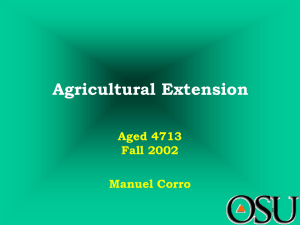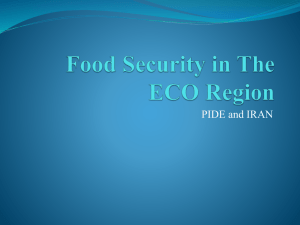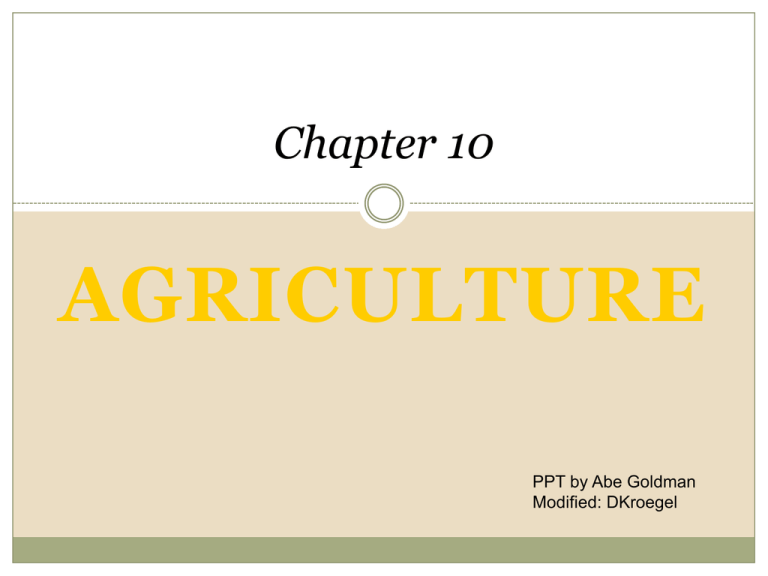
An Introduction to Human Geography
The Cultural Landscape, 8e
James M. Rubenstein
Chapter 10
AGRICULTURE
PPT by Abe Goldman
Modified: DKroegel
Economic Activities
Primary
Raw Materials: Agriculture, mining, fishing, and forestry
Secondary
Manufacturing: capital (for industry) and consumer goods
These three
levels are
often
subdivided
within the
economic
activity
group
“tertiary” as
services may
be utilized
by both
consumers &
producers.
Tertiary
Consumer: retail and personal services; entertainment
Quatrinary
Business/Producer services: trade, insurance, banking,
advertising, transportation and information services
Quinary
Public (government) Services: health, education, research,
transportation, tourism & recreation
Key Issue 1: Where Did Agriculture Originate?
Origins Of Agriculture
Hunters And Gatherers
• Contemporary Hunting And Gathering
Invention Of Agriculture
• Two Types Of Cultivation
Location Of Agricultural Hearths
Location Of First Vegetative Planting
Location Of First Seed Agriculture
Vocabulary
agriculture
crop
vegetative planting
seed agriculture
subsistence agriculture
commercial agriculture
prime agricultural land
agribusiness
• Diffusion Of Seed Agriculture
Classifying Agricultural Regions
Differences Between Subsistence And Commercial Agriculture
•
•
•
•
•
Purpose Of Farming
Percentage Of Farmers In The Labor Force
Use Of Machinery
Farm Size
Relationship Of Farming To Other Businesses
Mapping Agricultural Regions
Agricultural Origins and Regions
Origins of agriculture
Hunters and gatherers
Before the invention of agriculture, all humans probably obtain the food
they needed for survival by hunting for animals, fishing, or gathering
plants (including berries, nuts, fruits, and roots). Hunters and gatherers
lived in small groups, usually fewer than 50 persons, because a larger
number would quickly exhaust the available resources within walking
distance.
TODAY
Estimated 250,000 people living in isolated areas still live as hunter-gatherers
Arctic, and the interiors of Africa, South America and Australia
Invention of agriculture
Agriculture is the deliberate modification of Earth’s surface through
cultivation of plants and rearing of animals to obtain sustenance or
economic gain.
Dates back some 10 to 12 thousand years
Location of Agricultural Hearths
Location of
agricultural hearths
Vegetative planting
(aka root cropping) is the
reproduction of plants by
direct cloning from
existing plants, such as
cutting stems and dividing
roots [Cassava (manioc or
yucca), yams, sweet
potatoes]
Vegetative Planting Hearths
Fig. 10-1: There were several main hearths, or centers of origin, for vegetative crops
(roots and tubers, etc.), from which the crops diffused to other areas.
Agricultural Origins and Regions
Location of
agricultural
hearths
Seed agriculture
the reproduction of
plants through annual
planting of seeds that
result from sexual
fertilization
rice
millet
sorghum
flax
barley
wheat
Seed Agriculture Hearths
Fig. 10-2: Seed agriculture also originated in several hearths and diffused
from those elsewhere.
Carl Sauer: Location of Agricultural Hearths
Agriculture probably did not originate in one location, but
began in multiple, independent hearths, or points of origin.
From these hearths agricultural practices diffused across
Earth’s surface.
Vegetative planting
Southeast Asia (mainland) dDiffused to China, Japan, India and Southwest Asia,
Africa and the Mediterranean
West Africa
northwestern South America diffused to Central America and eastern South
America
Seed agriculture
western India (Pakistan/Indus River)
Northern China
Ethiopia
Carl Sauer: 11 areas of agriculture innovations
Agriculture probably did not originate in one location, but began in multiple,
independent hearths, or points of origin. From these hearths agricultural practices
diffused across Earth’s surface.
Animal Domestication
The best animals to farm are large, plant eating mammals. Over the years,
humans have probably tried to domesticate all of them, usually without
success. Despite repeated efforts, Africans have never domesticated the
elephant.
Animals which make suitable candidates for domestication have the
following characteristics:
start giving birth in their first or second years
have one or two offspring a year (so their productivity is high)
behaviorally they need to be social animals (males, females and the young live
together as a group)
get along with humans
internal social hierarchy
which means that if humans can control the leader, they will also gain control of
the whole herd.
Diamond counted 148 different species of wild, plant eating, terrestrial animals
that weigh over 100 pounds. Of those, we have only successfully farmed
for any length of time –just 14. They are: goats, sheep, pigs, cows,
horses, donkeys, Bactrian camels, Arabian camels, water buffalos,
llamas, reindeers, yaks, mithans and Bali cattle. All but one [llamas of
South America] of these animals are native to Asia, North Africa and Europe.
The Big Four livestock animals: cows, pigs, sheep and goats were native to the
Middle East.
U.S. Farms by Region
The number of farms
in the United States in
2008 is estimated at
2.2 million, 0.2 percent
fewer than in 2007.
Total land in farms, at
919.9 million acres,
decreased 1.56 million
acres, or 0.2 percent, from
2007.
The average farm size
was 418 acres,
unchanged from the
previous year. The decline
in the number of farms
and land in farms
reflects a continuing
consolidation in farming
operations and diversion
of agricultural land to
nonagricultural
uses.
USDA 2008 Report
NOTE: Map at left from 2002 but change in
farms from 2002 to 2008 would show little
visible change on the map.
Classifying Agricultural Regions
LDCs = subsistence agriculture
MDCs = commercial agriculture
Subsistence vs. commercial agriculture
Subsistence agriculture is the production of food primarily
for consumption by the farmer’s family
Commercial agriculture is the production of food primarily
for sale off the farm
Practice
Purpose
Subsistence
agriculture
LDCs
Personal
consumption
Commercial
agriculture
MDCs
Grow crops and
raise animals
primarily for sale
off the farm for
profit
Labor force
On average 55%
of workforce
engaged in
farming
On average 5% of
workforce
engaged in
farming
Machinery
Farm size
Off farm contact
Human and animal
powered tools
Very small
Occasional surplus sold
Mechanized farm
machines,
computer
technology and
science
agribusiness – farms one
part of a large food
Large [US
production industry
average in 2008 =
including food processing,
418 acres]
packaging, sorting,
distributing, and retailing
Labor Force in Agriculture
Fig. 10-3: A large proportion of workers in most LDCs are in agriculture, while only a small
percentage of workers in MDCs are engaged in agriculture.
Tractors, per Population
Fig. 10-4: Tractors per 1,000 people. Use of machinery is extensive in most MDC
agriculture, but it is much less common in LDCs.
Farmland Loss in Maryland
Fig. 10-1-1:
Overlaps of soil quality,
environmental and
cultural features, and
population growth may
show areas of greatest
threat of farmland loss in
Maryland.
Baltimore
Washington
DC
Baltimore and
Washington DC
population concentrations
have merged over time.
A serious problem in the United States has been the loss of the most productive
farmland, known as prime agricultural land, as urban areas sprawl into the
surrounding countryside.
Classifying Agricultural Regions
Mapping agricultural regions
World Agricultural Regions: Derwent Whittlesey, 1936
11 main agricultural regions
5 important to LDCs
6 important to MDCs
Climate influences the crop that is grown and/or animals raised
Relationship exists between climate and agriculture
Dry climate often equates to livestock ranching rather than farming
Culture influences agriculture
Hog (pig/swine) production low to nonexistent in predominantly Muslim
(and Jewish) regions due to religious taboo on pork.
World Agriculture Regions
Fig. 10-5a: Locations of the major types of subsistence and commercial agriculture.
World Climate Regions
Fig. 10-5b: Simplified map of the main world climate regions (see also Fig. 2.2).
Sources
Rubenstein, James M., The Cultural Landscape An Introduction to Human
Geography, 8th Edition, Pearson Prentice Hall, New Jersey, 2005
De Blij, Harm J., Human Geography People Place and Culture, 8th Edition,
Wiley & Sons, 2007
National Geographic Video: Diamond, Jared, Guns, Germs and Steel
USDA 2002 Census of Agriculture
http://www.nass.usda.gov/research/atlas02/index.html
USDA Farms, Land in Farms, and Livestock Operations 2008 Summary,
February 2009
http://usda.mannlib.cornell.edu/usda/nass/FarmLandIn//2000s/2009/Far
mLandIn-02-12-2009.pdf
Maps of the World, World Climate Map; http://www.mapsofworld.com/worldmaps/world-climate-map.html
Practical Farmers of Iowa, What is Ridge-Till?
http://www.pfi.iastate.edu/OFR/RT_description.htm

